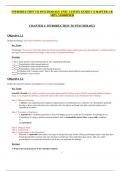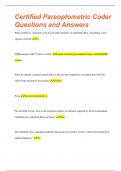Week 10 Transcript
Male reproductive patho
00:01
Here we’ll take a look at the male reproductive pathology.
00:03
And just like we have done in many organ systems, we shall also approach
this in an organized fashion.
00:09
Let’s begin.
00:13
We’ll begin our discussion by looking at congenital male reproductive
pathology and here, you’ll notice just a couple of topics in which which I’ve
kind of integrated them so that you can get a good idea as to what you can
expect in terms of development of the testis.
00:29
If you notice a picture on the left -- So this will be embryologically.
00:34
If you notice on the left that the fetus and the testis are located up in the
abdomen.
00:40
And at some point in time, the gubernaculum, which you see in picture B
here is going to literally pull the testis down into the scrotum.
00:49
And there’s a condition in which, if at any point in the testis do not properly
descend into the scrotum, we have problems of undescended testis.
00:59
In other words, cryptorchidism.
01:01
We’ll talk about that in greater detail when we talk about testicular tumors.
01:05
,Anytime there is cryptorchidism or there is improper descent of the testis into
the scrotum, then you’re worried about cancer developing in your male,
unfortunately.
01:17
Next, we have a little structure here called the processus vaginalis.
01:21
Just a quick little overview of anatomy here.
01:24
And on the bottom, you’ll notice numbers.
01:27
And number one, when we get to letter D here in the illustration, is what if you
had openings either on the dorsum or the ventral aspect of the penis.
01:38
You call this either hypo- which means the bottom, but more importantly,
make sure that you know the description of it.
01:45
So even though this is bottom of the penis, you then call this
what? The? Good.
01:50
Ventral portion.
01:51
Clear? So now, what is your patient what is your child predisposed
to? Infection.
01:57
Infection.
01:58
Hypospadia more common than epispadia but there are complications that
you want to know for both.
02:04
In hypospadia, it is once again the ventral portion of the penis that is failure to
fuse if you remember from embryology.
02:12
Whereas epispadia, as the name implies, would be the – Well, that would be
the top of the penis, but they’re not going to say “top of the penis.” Clinically,
they’ll call it what? The dorsum.
,02:20
Same concept.
02:22
What’s the dorsum of your foot? When you say dorsiflex, what are you
doing? You’re taking the foot and you’re moving it towards your leg, aren’t
you? Well, here, you have the top of the penis, which is the epispadia.
02:31
Failure to fusion here, what’s your complication in a child? It’s called bladder
extrophy.
02:37
E – epispadia. E – extrophy.
02:41
Now the complications as I said, hypoaspadia is more common than
epispadia.
02:45
Take a look at number one so that you know as to where you are vicinity-wise.
02:49
Number two, as the name implies, well, bladder exstrophy.
02:52
But in addition to that, there are a couple of other things here that you want to
know.
02:56
If you have failure of your lateral fusion of your abdomen, then you can have
what’s known as an omphalocele.
03:03
And an omphalocele would mean that you have herniation of the abdominal
organs in a child.
03:09
And when this happens, it is still covered by the peritoneum.
03:12
Keep that in mind.
03:13
Omphalocele, the failure of lateral fusion.
03:16
, In embryology, we’ve also looked at gastroschisis and that would mean that
the peritneum is not covered.
03:22
A couple embryologic issues.
03:24
Hydrocele: Well, with hydrocele (see number 3), what ends up happening is
that there’s accumulation of fluid surrounding the testis, between the visceral
and parietal layers of the tunica vaginalis.
03:38
And we’ll talk more about hydrocele when the time is right and we’ll compare
hydrocele to varicocele.
03:43
And for us, varicocele will play more of a role in pathology, but hydrocele, just
as important.
03:50
A quick little overview of your embryology and then some of the associated
pathologies that you’ve seen.
03:55
Let us keep moving.
Diagnoses of reproductive hormone disorders
Let's have a look at a patient who has Klinefelter syndrome. The most
common chromosomal abnormality that you will encounter will be the 47 XXY
type. Take a look at the patient. Tall, lanky. Take a look at the arm span. So
obviously you have a tall individual. And as a differential perhaps Marfan. But
with Marfan, quite simple. Looking for issues in which the fibrillin gene, the
elastic tissue and such has been compromised. And arachnodactyly so on
and so forth. In Klinefelter, you'll notice that we have arm span that's quite
long and then also take a look at the eunuchoid features. Eunuchoid referring
to features of both a man and a lady. You'll notice that the breast here are
gynecomastic. And at the same time though the facial features might be that
of a male. A patient with Klinefelter may present with infertility. And this is due
to the fact that, that there is loss of the sertoli cells or maybe even perhaps
fibrosis taking place of the seminiferous tubules. Please picture in the testis
the sertoli cells which are then responsible for proper maturation of
Male reproductive patho
00:01
Here we’ll take a look at the male reproductive pathology.
00:03
And just like we have done in many organ systems, we shall also approach
this in an organized fashion.
00:09
Let’s begin.
00:13
We’ll begin our discussion by looking at congenital male reproductive
pathology and here, you’ll notice just a couple of topics in which which I’ve
kind of integrated them so that you can get a good idea as to what you can
expect in terms of development of the testis.
00:29
If you notice a picture on the left -- So this will be embryologically.
00:34
If you notice on the left that the fetus and the testis are located up in the
abdomen.
00:40
And at some point in time, the gubernaculum, which you see in picture B
here is going to literally pull the testis down into the scrotum.
00:49
And there’s a condition in which, if at any point in the testis do not properly
descend into the scrotum, we have problems of undescended testis.
00:59
In other words, cryptorchidism.
01:01
We’ll talk about that in greater detail when we talk about testicular tumors.
01:05
,Anytime there is cryptorchidism or there is improper descent of the testis into
the scrotum, then you’re worried about cancer developing in your male,
unfortunately.
01:17
Next, we have a little structure here called the processus vaginalis.
01:21
Just a quick little overview of anatomy here.
01:24
And on the bottom, you’ll notice numbers.
01:27
And number one, when we get to letter D here in the illustration, is what if you
had openings either on the dorsum or the ventral aspect of the penis.
01:38
You call this either hypo- which means the bottom, but more importantly,
make sure that you know the description of it.
01:45
So even though this is bottom of the penis, you then call this
what? The? Good.
01:50
Ventral portion.
01:51
Clear? So now, what is your patient what is your child predisposed
to? Infection.
01:57
Infection.
01:58
Hypospadia more common than epispadia but there are complications that
you want to know for both.
02:04
In hypospadia, it is once again the ventral portion of the penis that is failure to
fuse if you remember from embryology.
02:12
Whereas epispadia, as the name implies, would be the – Well, that would be
the top of the penis, but they’re not going to say “top of the penis.” Clinically,
they’ll call it what? The dorsum.
,02:20
Same concept.
02:22
What’s the dorsum of your foot? When you say dorsiflex, what are you
doing? You’re taking the foot and you’re moving it towards your leg, aren’t
you? Well, here, you have the top of the penis, which is the epispadia.
02:31
Failure to fusion here, what’s your complication in a child? It’s called bladder
extrophy.
02:37
E – epispadia. E – extrophy.
02:41
Now the complications as I said, hypoaspadia is more common than
epispadia.
02:45
Take a look at number one so that you know as to where you are vicinity-wise.
02:49
Number two, as the name implies, well, bladder exstrophy.
02:52
But in addition to that, there are a couple of other things here that you want to
know.
02:56
If you have failure of your lateral fusion of your abdomen, then you can have
what’s known as an omphalocele.
03:03
And an omphalocele would mean that you have herniation of the abdominal
organs in a child.
03:09
And when this happens, it is still covered by the peritoneum.
03:12
Keep that in mind.
03:13
Omphalocele, the failure of lateral fusion.
03:16
, In embryology, we’ve also looked at gastroschisis and that would mean that
the peritneum is not covered.
03:22
A couple embryologic issues.
03:24
Hydrocele: Well, with hydrocele (see number 3), what ends up happening is
that there’s accumulation of fluid surrounding the testis, between the visceral
and parietal layers of the tunica vaginalis.
03:38
And we’ll talk more about hydrocele when the time is right and we’ll compare
hydrocele to varicocele.
03:43
And for us, varicocele will play more of a role in pathology, but hydrocele, just
as important.
03:50
A quick little overview of your embryology and then some of the associated
pathologies that you’ve seen.
03:55
Let us keep moving.
Diagnoses of reproductive hormone disorders
Let's have a look at a patient who has Klinefelter syndrome. The most
common chromosomal abnormality that you will encounter will be the 47 XXY
type. Take a look at the patient. Tall, lanky. Take a look at the arm span. So
obviously you have a tall individual. And as a differential perhaps Marfan. But
with Marfan, quite simple. Looking for issues in which the fibrillin gene, the
elastic tissue and such has been compromised. And arachnodactyly so on
and so forth. In Klinefelter, you'll notice that we have arm span that's quite
long and then also take a look at the eunuchoid features. Eunuchoid referring
to features of both a man and a lady. You'll notice that the breast here are
gynecomastic. And at the same time though the facial features might be that
of a male. A patient with Klinefelter may present with infertility. And this is due
to the fact that, that there is loss of the sertoli cells or maybe even perhaps
fibrosis taking place of the seminiferous tubules. Please picture in the testis
the sertoli cells which are then responsible for proper maturation of











